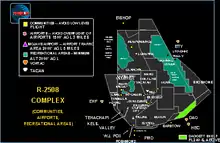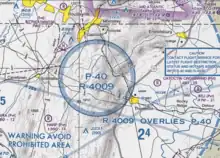
Special use airspace (SUA) is a type of special airspaces in the United States designated for operations of a nature such that limitations may be imposed on aircraft not participating in those operations. Often these operations are of a military nature. The designation of SUAs identifies for other users the areas where such activity occurs, provides for segregation of that activity from other users, and allows charting to keep airspace users informed of potential hazards.
Most SUAs are depicted on aeronautical charts and listed on FAA websites. Overlying Air traffic controllers can also provide SUA information.
Types
The Aeronautical Information Manual includes the following SUAs:[1]
| Name | Purpose | Permission to entry | Example | Chart depiction | Notes |
|---|---|---|---|---|---|
| Prohibited Area | Established for security or other reasons associated with the national welfare | No aircraft may enter[Note 1] | P-40 surrounding Camp David | Name starts with "P-" and delineated with | The area may expand or shrink based on activities on the surface |
| Restricted Area | Denote the existence of unusual, often invisible, hazards to aircraft such as artillery firing, aerial gunnery, or guided missiles | Require clearance from the controlling agency | R-4808N surrounding Area 51 | Name starts with "R-" and delineated with | |
| Warning Area | Extend from 3 nautical miles outward from the coast of the U.S., that contains activity that may be hazardous to nonparticipating aircraft. | Require clearance from the controlling agency when active | Name starts with "W-" and delineated with | May be located over domestic or international waters or both | |
| Military Operations Area (MOA) | Separate certain military training activities from IFR traffic | VFR traffics may enter with caution; IFR traffic may be re-routed | Duke MOA[4] | Name ends with "MOA" and delineated with | Military aircraft authorized to travel faster than 250 knots below 10,000 feet altitude |
| Alert Area | Inform nonparticipating pilots of areas that may contain a high volume of pilot training or an unusual type of aerial activity | Not required | A-211, flight training near Miami International Airport[5] | Name starts with "A-" and delineated with | All activities strictly adhere to Federal Aviation Regulations with no waivers |
| Controlled Firing Areas (CFA) | Contain activities that may be hazardous to nonparticipating aircraft, but ceased immediately when spotter aircraft, radar, or ground lookout positions indicate an aircraft might be approaching the area | Not required | Non-aircraft ordnance disposal, blasting, and static testing of large rockets.[6] | Not depicted on charts | |
| National Security Area (NSA) | Need for increased security and safety of ground facilities | Requested to avoid overflying | Portsmouth Gaseous Diffusion Plant | Thick dashed magenta lines | Flying may be temporarily prohibited |
Other airspace areas
A few airspaces that are considered neither special use airspaces nor the typical controlled / uncontrolled airspaces include:[7]
- Military Training Routes (MTR)
- For military aircraft's training on “low level” combat tactics. The routes are further divided into IFR Military Training Routes (IR) and VFR Military Training Routes (VR).[7]: 3-5-2
- Temporary Flight Restrictions (TFR)
- To protect persons and property in the air or on the surface from an existing or imminent hazard associated with an incident on the surface when the presence of low flying aircraft would magnify, alter, spread, or compound that hazard. These include public figure visits, disaster relieves, sports events, and space-launch missions.[7]: 3-5-3.b
- Parachute Jump Aircraft Operations[7]: 3-5-4
- Published VFR Routes
- Help pilots transition around, under and through complex airspaces. These routes include “VFR Flyway”, “VFR Corridor”, and “Class B Airspace VFR Transition Route”.[7]: 3-5-5
- Terminal Radar Service Area (TRSA)
- Not controlled airspace from a regulatory standpoint, but air traffic control radar services are available nonetheless.[7]: 3-5-6
- Special Flight Rules Area (SFRA)
- Certain designated airspaces with special air traffic rules for aircraft operating, as regulated by 14 CFR Part 93.[7]: 3-5-7
- Weather Reconnaissance Area (WRA)
- Established to support weather reconnaissance/research flights. ATC services are not provided within these areas. Only participating weather reconnaissance/research aircraft from the 53rd Weather Reconnaissance Squadron and National Oceanic and Atmospheric Administration Aircraft Operations Center are permitted to operate within a Weather Reconnaissance Area.[7]: 3-5-8
- Air Defense Identification Zone (ADIZ)
- An area of airspace over land or water, in which the ready identification, location, and control of all aircraft (except Department of Defense and law enforcement aircraft) is required in the interest of national security.[8]: 5-6-3.a
- Altitude Reservation (ALTRV)
- This airspace ensures non-participating IFR aircraft remain separated from special activity. Non-participating VFR aircraft are permitted to fly through the area with caution.[7]: 3-5-9.a
- Air Traffic Control Assigned Airspaces (ATCAA)
- Airspaces assigned by air traffic controllers for the purpose of providing air traffic segregation between the specified activities being conducted within the assigned airspace and other IFR air traffic.[7]: 3-5-9.b
Charts

All permanent SUA areas, except for controlled firing areas, are depicted on aeronautical charts, including sectional aeronautical charts, VFR terminal area charts, and applicable en-route charts, accompanied with these areas' respective the hours of operation, altitudes, and the controlling agency. Controlled firing areas, temporary military operations areas, and temporary restricted areas are not shown on the charts.[1]: 3-4-1
Notices
In addition to charts, pilots can verify the status of permanent SUAs by contacting the using or controlling agency. These contact information are included in chart margins. For temporary or permanent SUAs requiring a NOTAM for activation, an airspace NOTAM will be issued, and pilots can the SUA status via air route traffic control centers. Alaska's military operation runs Special Use Airspace Information Service to inform civilian VFR traffic about certain military operation areas and restricted airspaces within central Alaska.[1]: 3-4-9
Outside the U.S.
SUAs are more commonly recognized by International Civil Aviation Organization as Flexible Use of Airspace (FUA),[9]: Appendix A. Part II. Article 1. an airspace management concept where airspaces should never be designated as purely civil or military, but rather as a continuum in which all user demands are accommodated to the greatest possible extent.[9]: 3.2.1
Notes
- ↑ Unless authorization has been granted by the agency, organization or military command that established the requirements for the prohibited area.[2] Such rarely authorized aircrafts include the United States President's helicopter.[3]
References
- 1 2 3 "Chapter 3. Airspace. Section 4. Special Use Airspace". Aeronautical Information Manual. Federal Aviation Administration. Retrieved 14 January 2024.
 This article incorporates text from this source, which is in the public domain.
This article incorporates text from this source, which is in the public domain. - ↑ "PART 73—SPECIAL USE AIRSPACE". Code of Federal Regulations. p. 73.83. Retrieved 15 January 2024.
- ↑ Shogan, Colleen (March 8, 2021). "Camp David". The White House History Association. Retrieved 15 January 2024.
- ↑ "Duke MOA Low". www.175wg.ang.af.mil. 175th Wing. Retrieved 14 January 2024.
- ↑ Namowitz, Dan (30 June 2017). "Training Tip: Unusual aerial activity". Aircraft Owners and Pilots Association. Retrieved 14 January 2024.
- ↑ Fritts, Sarah (2 March 2017). "Everything You Need to Know About Controlled Firing Areas". ThinkAviation. Retrieved 14 January 2024.
- 1 2 3 4 5 6 7 8 9 10 "Chapter 3. Airspace. Section 5. Other Airspace Areas". Federal Aviation Administration. Retrieved 14 January 2024.
 This article incorporates text from this source, which is in the public domain.
This article incorporates text from this source, which is in the public domain. - ↑ "Chapter 5. Air Traffic Procedures. Section 6. National Security and Interception Procedures". Federal Aviation Administration. Retrieved 14 January 2024.
- 1 2 "Cir 330. AN/189. Civil/Military Cooperation in Air Traffic Management" (PDF). Montréal: International Civil Aviation Organization. Retrieved 14 January 2024.
External links
- Special Use Airspace & Air Traffic Control Assigned Airspace, contains currently active SUAs